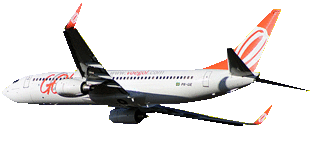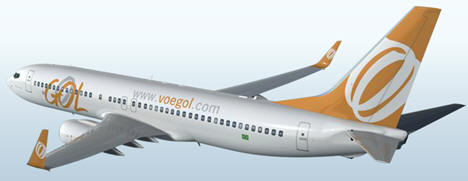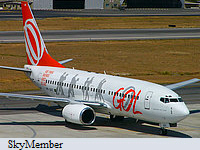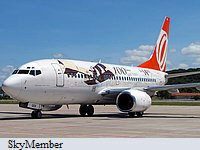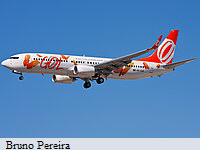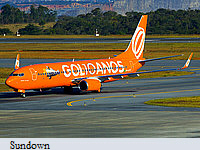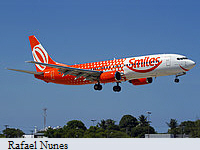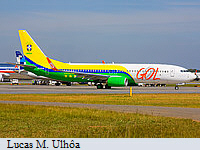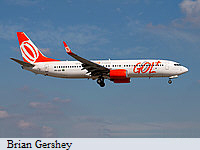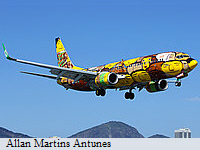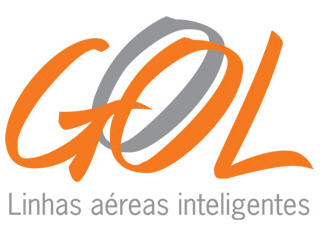Gol airlines
introduced the "Low Cost, Low Fare" concept in Brazil. The airline was
established on August 2000 and started operations on January 15, 2001 with
four Boeing 737-700. It belongs to Áurea group, one of the largest
transportation groups in the country. JetBlue, targeted to business market
where travellers want quality and low price, inspired Gol. To reduce costs,
the company outsourced everything, removed stove from aircrafts (for more
seats), less crew and sales only by internet or phone. Moreover, the
aircraft fly at a greater altitude and spend less time on the ground,
thereby the aircraft burn less fuel and flies more per day. Thus, Gol's cost
was much smaller than its competitors were.
In November 2001, Gol was authorized to operate at
Santos Dumont airport
and Rio and São Paulo route, Brazil’s busiest route. With lowest price,
others airlines were forced to reduce prices. Gol conquered many passengers
by 50% lower prices, mainly who had never travelled by plane before, only by
bus. The airline also banned papers tickets, its passenger only needed the
reservation code for check-in.
On January 15, 2002 Gol completed one year and transported more than 2
million passengers, with 62% of load factor (58% was the goal). On its
birthday, Gol was flying to 17 domestic destinations and ordered more two
Boeing 737-700 and two 737-800. The first Boeing 737-800 was received in
2003.
On December 22, 2004 Gol started its first international to Buenos Aires.
Gol was the most successful airline in Brazil, with exponentially grow and
increasing profits. The company was also the fourth most profitable airline
in the world! Its operating profit was the twentieth largest in the world
among airlines in 2004. Gol announced the largest aircraft order by a
Brazilian airline: 43 aircraft with option to 101!
In 2005 expanded internationally, launching flights to Santa Cruz de la
Sierra and Asuncion. In April, beat Varig and become
the second largest in domestic market.
On April 28, 2007 Gol announced the acquisition of VRG Linhas Aereas (“new”
Varig) for about 400 million dollars. Gol's ambition was to expand its
routes to Europe and the United States and beat
Tam
as the largest airline in Brazil. Varig received new Boeing 737-700 and
737-800 and eleven old Boeing 767-300 and one Boeing 767-200. The first new
intercontinental flight was Sao Paulo-Paris-Rome. Then to London, Madrid and
Mexico. Nevertheless, the plan was not as expected. Varig’s poor load factor
and high fuel price, generated losses for the first time in Gol’s history.
In 2008 the airline reduced the intercontinental network to Paris and
Madrid only. However, Varig’s load factor still below 50%. So all
intercontinental flights were terminated and Varig’s operations were merged
with Gol. Officially, VRG Linhas Aéreas absorbed Gol because of several tax
benefits. At the end of the year, Gol launched "Comfort Class", offered in
flight operated by Varig, which more benefits such as lounges, more miles in
fidelity program and better on-board services.
Early 2009 the load factor of international flights fall around 50% and Gol
did not think twice and ended flights to Lima and reduced flights to
Santiago, Caracas and Bogota. Gol also began offering sandwiches instead of
cereal bar in some flights. But the main focus was Smiles (Varig’s fidelity
program). In 2009 Gol sign agreements with Air France, KLM, American
Airlines and made many marketing actions. At the end of 2009 the load factor
improved greatly and Gol was close to beat Tam as the leadership in domestic
market.
In 2010 four Boeing 767-300 were reactivated to operate charter flights,
until Gol find someone to buy it. In addition Gol also returned to invest in
international market with flights to Caribbean. In July, Smiles announced an
agreement with Delta.
In February 2011 Gol beat Tam for first time in domestic market, but was
beat by Tam in next month. Also at the beginning of 2011 Gol finally retired
its last Boeing 737-300. In September the company launched "Gol No Ar" an
entertainment portal that can be accessed by mobile phones, notebooks and
tablets on board aircraft through Wi-Fi.
On June 1, 2011 Gol cancelled flights to Bogota due strong competition with
Avianca. In the same month was the first airline in Latin America to receive
and operate Boeing 737 with "Sky Interior".
On July 8, 2011 acquired
WebJet
for BRL310 million. Gol's initial intention was extinguish
WebJet
brand, but due negative reaction of the government institution (CADE), the
airline changed its mind.
In December 2011 Delta Air Lines invested US$ 100 million in Gol, getting a
share of approximately 3%. The two airline expanded code-share agreement and
Gol started selling on its website flights to Atlanta, Boston, Chicago,
Washington, Los Angeles, among others, operated by Delta.
In October 2012 Gol announced an order for 60 new generation Boeing 737MAX
and stopped flying to Santiago. In November announced the end of
WebJet
brand and the retirement of all
WebJet's
Boeing 737-300.
In December, started scheduled flights to the United States (Miami and
Orlando, with a stop in Santo Domingo).
In 2013 Gol became the official carrier of the Brazilian soccer team and
created "Gol + Conforto", with more space between the seats. Besides
focusing on more comfort to passengers, Gol also initiated a strategy to
increase its revenue in dollars, expanding its international network.
In February 2014, Air France-KLM bought 1.5% of Gol. In July the company
increased its flights to the US and returned to Santiago.
On July 15, 2015 Gol presented its new visual identity, the first visual
change since the company's founding in 2001. In August the company received
the first Boeing 737-800 equipped with Scimitar Winglets.
At the end of 2015 Gol canceled flights to the USA and Caracas, in
addition to reducing the international and national seat offer.
In March, 2016 the company launched the "Gol Premium", a kind of "premium
economy class" on international flights. On October, 4th Gol made the first
commercial flight with Internet on board, between São Paulo and Brasília.
Paint Shame:
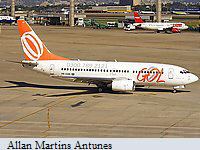
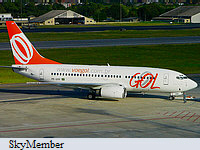
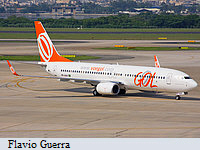
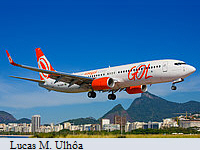
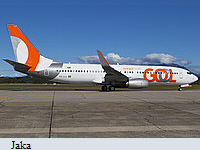
| Logos:
Cargo subsidiary
|
Founded: 2001
Hubs: Congonhas,
Santos Dumont,
Guarulhos, Galeão,
Confins
Headquarters:
São Paulo
Code:
GLO / G3
Current Fleet:
Boeing 737-700, Boeing 737-800
Domestic Destinations:
Porto Alegre, Caxias do Sul, Chapecó, Florianópolis,
Navegantes, Joinville, Curitiba, Foz do Iguaçu, Maringá, Londrina, São Paulo, Campinas, Presidente Prudente, Bauru, Rio de
Janeiro, Belo Horizonte, Uberlândia, Montes Claros, Vitória, Brasília, Goiânia, Campo Grande, Cuiabá, Palmas, Salvador, Porto Seguro, Ilhéus, Petrolina, Aracaju,
Maceió, Recife, João Pessoa, Fernando de Noronha, Natal, Campina Grande,
Fortaleza, Juazeiro do Norte, Teresina, Imperatriz, São Luis, Belém, Carajás, Marabá, Santarém, Macapá, Manaus, Porto Velho, Rio
Branco, Cruzeiro do Sul, Boa Vista
International Destinations: Montevidéu, Buenos Aires, Córdoba, Rosário,
Assunção, Santiago, Santa Cruz de La Sierra, Punta Cana, Paramarimbo
Destinations (total): 60
Formerly international destinations: Caracas, Aruba, Barbados,
Curaçao, Santo Domingo, Miami, Orlando
Code-Share:
Copa, Air France-KLM,
Delta,
Aerolineas Argentinas,
Iberia, Qatar Airways
Updated 2017
